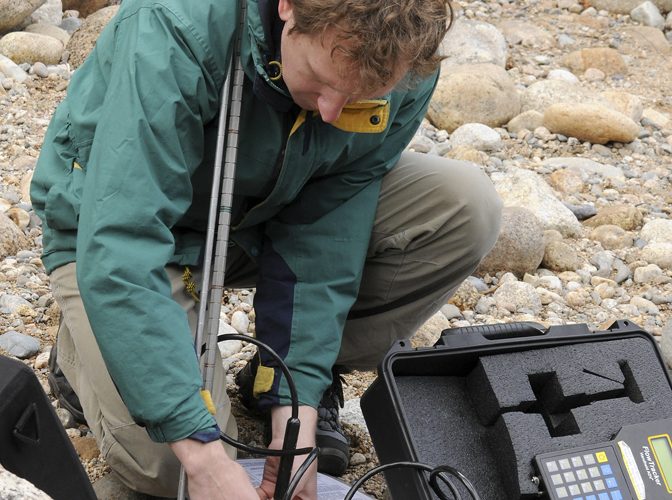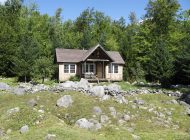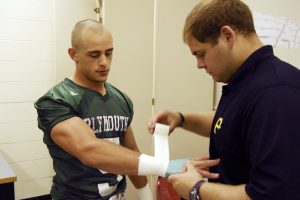How a group of science-savvy volunteers is working to keep their local river healthy—with a little help from PSU.
by Jennifer Philion

PSU students Chris Nealen and Kristin Brandt take water temperature, specific conductivity, and pH measurements. Monitoring these characteristics can help researchers track a river’s health. Jon Gilbert Fox photo.
THE ISRAEL RIVER BEGINS at the foot of New Hampshire’s Mount Adams, flowing north-westward through the town of Randolph, Jefferson, and Lancaster before emptying into the Connecticut River. It’s roughly 24 miles of scenic, healthy river, and an unusual partnership of local volunteers and Plymouth State scientists and students is studying some of its most basic components—water isotopes—to help make sure it stays that way.
“It’s citizen science,” says Professor of Hydrology Mark Green with the University’s Center for the Environment. “When locals are invested in their river, they can take on the role of monitoring it.”
“The volunteers are out taking water samples, and we do the measurements with equipment we have here,” Green says. Because the Israel River is in good condition, he says, this project will help establish a “hydrologic control of the water system”: a baseline of data that any future changes can be measured against.
That’s exactly what the Israel River Volunteer Advisory Group is hoping for. “Our major goal has been to establish a credible baseline of water quality parameters, which can be used for planning purposes by local and state commissions and agencies,” says Bob Ball, a member of IRVAG who was involved in the group’s formation in 2005. Members are citizens who are concerned about the “long-term health of the Israel River that flows through our towns.”
“We currently have about 20 volunteers who got involved because they recognize the importance of this river from an ecological, economic, and historical perspective,” Ball says. Since it began, the group has been working with the Volunteer River Assessment Program that is operated by the New Hampshire Department of Environmental Services, collecting water samples, taking field measurements, conducting studies, and producing a detailed annual report about the river.
Early Stages
The water isotope study grew out of a project in the winter of 2009–10, in which IRVAG sought help measuring the effects of road salt on the river. Green, who came to PSU in August 2009, brought a personal interest in hydrological mapping and additional resources that could be used in an expanded project.
“When I threw out the idea of isotope study to the volunteer group, they latched onto it,” Green says. “It was a useful way to add technology to their monitoring efforts, and at the same time it helps me get a better idea of the hydrology of the region.”
The members of IRVAG were happy to find more expertise and equipment they could tap into. “We had a great experience with the people at PSU on the chloride project last winter and were excited by the opportunity to expand our partnership,” Ball says.
Taking Fingerprints
Isotopes are atoms of a chemical element that have the same atomic number but different atomic weights, thanks to differing numbers of neutrons in the atoms’ nuclei. For example, carbon-12 has six protons and six neutrons, and carbon-14 has six protons and eight neutrons.
Breaking water down to an atomic level allows scientists to identify its different isotopes and match them with water sources where the same isotopes are found—a process known as “isotopic fingerprinting.”
By taking groundwater samples from different points near the Israel River and examining their isotopic structure, then comparing that with the isotopes within samples of river water, “we can determine how much of the Israel’s water comes from those groundwater sources, versus other sources such as precipitation, and which areas contribute more groundwater than others,” Green says. “In this way, we can map the watershed.”
Understanding where the water comes from can help IRVAG members in their quest to keep the river healthy. As a simple example, Green explains, if there is a particular area from which a lot of groundwater enters the river, communities could make sure to keep possible pollutants out of that area.
The volunteer group is eager for information on the river’s relationship with its surroundings. “While we are starting to get a better view of the chemistry of the water in the river through our monitoring program, we have little understanding of the dynamics of the mix between surface water and water from the underground aquifers,” Ball says.
“Overall, there are a lot of unanswered questions about the role of acid rain, bedrock formations in the White Mountain Region, and wetlands in our watershed in stabilizing pH and chloride levels in our river. We are hoping this isotope study and the expertise at PSU will help us gain a better understanding of these issues, so we can determine what mitigation steps might be possible to protect this valuable natural resource.”
Ongoing Partnership

Professor Mark Green sets up testing equipment on the shore of the Pemigewassett. Jon Gilbert Fox photo.
After volunteers from IRVAG collect river and groundwater samples, the processing and analysis is done in a laboratory at PSU’s Center for the Environment. Kristin Brandt, an environmental science and policy graduate student, is running samples: she carefully fills a syringe with a water sample and injects it into what she calls “the magic black box”—a cavity ring-down spectrometer. The machine vaporizes the water samples and measures the abundance of “heavy” oxygen and hydrogen atoms, so the presence of these isotopes can be compared with other samples.
Brandt, who earned her bachelor’s degree from the University of Arizona, began her graduate work in the fall and quickly became interested in Green’s focus on isotope study. “Isotopes are great,” she says. “You’re directly measuring the water’s makeup.”
While she has just started assisting Green in working on the Israel River project, Brandt looks forward to continuing the relationship. The environmental science and policy program requires graduate students to include outreach work in their theses, giving students an opportunity to collaborate outside the classroom with a local organization in their research area. “When the Israel River group came to Mark, it was a good fit to work them into the outreach portion of my thesis,” Brandt says. “Once we see where we can find groundwater sources that go into the river, I’m hoping the research will have management implications.”
Local Commitment
IRVAG members also do their part to get local students involved in their river activities, working with the Environmental Sciences program at the White Mountain Regional High School. “The students from that class typically do all the field monitoring activities for the month of October as part of the their curriculum,” Ball says.
Green says that although the isotope study has been largely informal, he is impressed with IRVAG members’ enthusiasm in performing the fieldwork and learning more about how this research can be valuable. “It’s unusual to do this kind of project with a group of citizen volunteers,” he says.
This group, admittedly, is not your average gathering of laypeople. Dedicated to and educated about their river, they readily embrace the chance to learn more. “Once the group learned about isotopes, they got really interested in the science,” Green says. “They’re now understanding isotopic geochemistry and its practical applications. It’s so exciting for me to see citizens so engaged.”
For Ball, the relationship with PSU is a valuable one that the volunteer group would like to see continue to grow. “Going forward, we would like to leverage expertise at the University, particularly in hydrology and surface water biology, that could help us to better understand the dynamics of our river,” he says.
“We believe the river is generally in excellent condition,” Ball says. And through a combination of volunteer energy and commitment, and PSU facilities and expertise, the communities along the Israel hope to keep their river healthy for generations to come.
Top: Professor Mark Green sets up testing equipment on the shore of the Pemigewassett. Jon Gilbert Fox photo.
Bottom: PSU students Chris Nealen and Kristin Brandt take water temperature, specific conductivity, and pH measurements. Monitoring these characteristics can help researchers track a river’s health. Jon Gilbert Fox photo.
Tags: Center For the Environment isotopes Israel River Israel River Volunteer Advisory Group Kristin Brandt Mark Green












